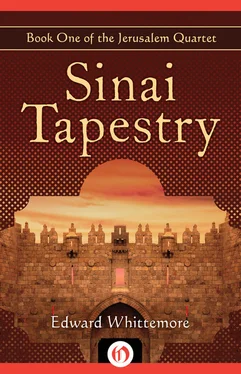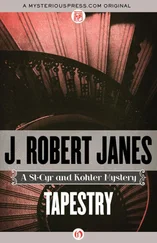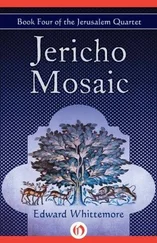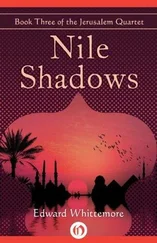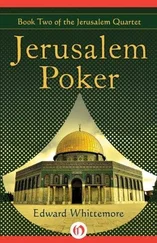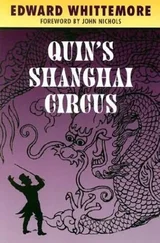As mentioned, Quin was a bigger success with the critics than it was in the bookstores. Readers loved the novel, even though there were not nearly enough of them. But Whittemore was not deterred. Less than two years later he appeared in my office with an even more ambitious novel, Sinai Tapestry , the first volume of his Jerusalem Quartet. Set in the heyday of the British Empire, it takes place in Palestine during the middle of the nineteenth century. Foremost among the larger-than-life characters were a tall English aristocrat, the greatest swordsman, botanist, and explorer of Victorian England; a fanatical trappist monk who found the original Sinai Bible, which “denies every religious truth ever held by anyone;” and an Irish radical who had fled to Palestine disguised as a nun. My favorite was (and still is) Haj Harun, born three thousand years earlier, an ethereal wanderer through history: now an antiquities dealer dressed in a faded yellow cloak and sporting a Crusaders’ rusty helmet while pursuing his mission as defender of the Holy City. He had several previous incarnations: as a stone carver of winged lions during the Assyrian occupation, proprietor of an all-night grocery store under the Greeks, a waiter when the Romans were in power, and a distributor of hashish and goats for the Turks. Before I first went to Israel in 1977, Whittemore, who was then living in New York, gave me the names of several people in Jerusalem. One was named Mohammed, the owner of an antiquities gallery. When I finally tracked him down in the Old City I saw before me a fey character who, if he had been wearing a faded yellow cloak and a rusty helmet, would have been a dead ringer for Haj Harun.
Clearly Ted had been caught up in a new life in Jerusalem. During the preceding years when he had been living modestly in Crete he had the opportunity to do a great deal of reading and thinking. Crete had a rich history. It had been occupied by the Romans, conquered by the Arabs, Byzantines, and Venetians before becoming part of the Ottoman Empire in the seventeenth century. Now it was a quiet, out-of-the-way Greek island with few distractions for a penniless American expatriate. In other words, a perfect place for a former intelligence agent to take stock and decide what history was all about, to re-examine what he had learned as a Yale undergraduate.
While in Japan in the 1960s Whittemore had written two unpublished novels, one about the Japanese game of Go, the other about a young American expatriate living in Tokyo. In Crete he began to write again, slowly, awkwardly, experimenting with voice, style, and subject matter, distilling his experience in the Agency into that sweeping raucous epic, Quin’s Shanghai Circus . By the time he embarked on the Quartet, he was more assured, he was a more polished writer, and he had found a subject that was to engage him for the rest of his life: Jerusalem and the world of Christians, Arabs and Jews; faith and belief; mysticism and religious (and political) fanaticism; nineteenth century; European imperialism, twentieth century wars and terrorism. But above all Jerusalem, the City on the Hill, the Holy City. The novels would still be full of outrageous characters, the humor was still often grotesque and macabre, and there was violence aplenty. But there was also a new understanding of the mysteries of life.
The new novel, finally published in 1979, was Jerusalem Poker , the second volume of the Quartet. It involves a twelve-year poker game begun in the last days of December 1921 when three men sit down to play. The stakes were nothing less than the Holy City itself. Where else could a game for the control of Jerusalem be played but in the antiquities shop of Haj Harun? Actually, Ted did not come to live permanently (that is “permanently” according to his ways) in Jerusalem until he was well into writing the Quartet. His knowledge of Jerusalem was based initially on books, but later on he wandered endlessly through the crowded, teeming streets and Quarters of the Old City. Merchants of every kind, butchers, tanners, glass blowers, jewelers, silversmiths, and even iron mongers spoke nearly every known language and dressed in the vibrant and exotic costumes of the Middle East. I once remarked to Ted while we were making our way along a narrow passage in the Arab Quarter, that I fully expected we would run into Sinbad the Sailor coming the other way.
The next time I visited Jerusalem, Ted had settled down with Helen, an American painter, in a spacious apartment in a large, nineteenth-century stone building in the Ethiopian Church compound. The apartment overlooked a courtyard full of flowers and lemon trees. Over one wall there loomed a Cistercian convent, and around the corner there was a synagogue full of Orthodox rabbinical students praying twenty-four hours a-day, or so it seemed to me. And standing or quietly reading in the courtyard were the Ethiopian monks. One morning I woke at six in my sunlit room and heard the Cistercian nuns singing a cappella. They sounded like birds and I thought for a moment I was in heaven.
After a midday nap we usually headed for the Old City, invariably ending up in the same cafe, a pretentious name for what was little more than an outdoor tea garden where hot tea and sticky buns were served. The proprietor sat at one table interminably fingering worry beads and talking to friends, an ever-changing group of local merchants, money changers, students, and some unsavory hard-looking types. They all seemed to have a nodding acquaintance with Ted, who knew as much, if not more, about the Old City as its inhabitants.
By 1981, Whittemore was living in a studio apartment on Third Avenue in New York City. And he was writing steadily. I had left Holt earlier that spring for another publishing house and a young colleague, Judy Karasik, took over the editorial work on Whittemore’s new novel, Nile Shadows . After Ted died, she wrote the epilogue to this novel. It is one of the most moving accounts of an editor’s working and personal relationship with an author I have ever read. She should have given it as a eulogy at Whittemore’s funeral twelve years after Nile Shadows appeared.
Nile Shadows is set in Egypt, it is 1942 and Rommel’s powerful Afrika Corps is threatening to overrun Egypt and seize control of the entire Middle East. A group of Whittemore’s characters, some old, some new, hold the fate of the world in their hands. At the very beginning of the novel, Stern, an idealistic visionary in Sinai Tapestry turned gun-runner a half century later, is killed by a grenade thrown into the doorway of a backstreet bar. Violence as well as mysticism dominates Whittemore’s novels. In Quin’s Shanghai Circus he had described with horrible abandon the “rape” of Nanking and Sinai Tapestry the sack of Smyrna in 1922 when the Turks butchered ten of thousands of Greek men, women, and children. A Publishers Weekly reviewer said of Nile Shadows : “One of the most complex and ambitious espionage stories ever written.” And a critic in The Nation said: “Whittemore is a deceptively lucid stylist. Were his syntax as cluttered as Pynchon’s or as conspicuously grand as Nabokov’s or Fuentes’, his virtually ignored novels might have received the attention they deserved.”
But sales still hadn’t caught up with the critics. By the spring of 1985, Ted was finishing the novel that was to be called Jericho Mosaic , the fourth of the Jerusalem Quartet. I was in Israel for the biennial Jerusalem International Book Fair. Afterwards, Ted suggested we drive down to Jericho, that oasis to the southeast of Jerusalem from which most of the caravans of Biblical times set out for the Levant, Asia Minor, and Africa. On the way we visited several Greek Orthodox monasteries in the Judean wilderness. Since they were built into solid rock at the bottom of isolated ravines reachable only on narrow paths, we had to leave the car up on the road and scramble down hillsides more suitable for mountain goats than a novelist and a New York editor. However, once we made it safely to the bottom, the monks proved to be extremely hospitable. Whittemore was a frequent visitor and the monks seemed to enjoy his company.
Читать дальше
